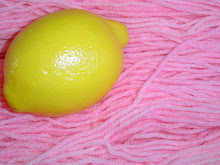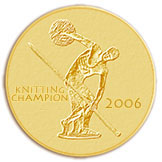I got a lot of spinning done this weekend!

I'm a little in shock at how much I got done. As you can see on the left, I finished spinning the Frostrosen singles, so now those are waiting for plying (in line behind Opalessence), and I also spun up half of the 5.25 ounces of pink GCNI/Mohair that I painted a few weeks ago. Obviously, I've got to figure out how to wind a bobbin on the Symphony - by weight, there is more fiber on the Frostrosen bobbin than the pink bobbin, but while the Frostrosen is wound nice and firm, the pink bobbin is kind of, well, fluffy. I think it has something to do with the stationary flyer hooks of the Symphony versus the sliding butterfly loop on the Rose. I've already started spinning on the second bobbin of pink and I'm about 1/3 of the way through (I told you I got a lot of spinning done!) and I think I'm doing a better job of loading this bobbin - I'm moving the singles along the hooks faster. Hopefully, doing that will load the bobbin more evenly. I've got the Rose all set up to ply but I know that plying the Opalessence will probably take a while, so I don't know if I'll get to it today.
A couple of people had asked in the comments Friday about cabled yarn. In a "normal" yarn, you spin the singles one direction, then ply them together the other direction. For Western style knitting (I'm not going to get into a big explanation of Western vs. Eastern styles of knitting - Knitting in the Old Way has a really good explanation of this if you're interested) you want the final twist direction of your yarn to be counterclockwise, or S twist. Still with me? OK, to make a cabled yarn, you spin your singles one direction, ply them together the opposite direction - but OVERPLY them. You don't want a balanced yarn at this point. Then you take your overplied yarn (either two ends of a center pull ball or two bobbins) and ply it again, in the first spinning direction, balancing out the twist. If you know you're going to make a cabled yarn from the first, you'd spin your singles S twist (this is opposite of what you'd do if you were just making a "normal" plied yarn), overply Z twist, then reply in S twist again. The advantages of a cabled yarn are that it will really make your spinning look even - doing all that plying gives you a very consistent yarn, it makes a strong yarn, and since its twisted back on itself so many times, it can really cut down on pilling if you've used fibers that tend to pill. The disadvantages are that you have to spin 4 times the length of singles as your finished yarn, there is an extra plying step, and if you don't spin the singles very fine, you will have a huge finished yarn.
Labels: Frostrosen, Spinning for Socks










2 Comments:
Just gorgeous! I am just amazed at everything you do anyhow. I know those who visit your blog will not be disappointed.
The cable instructions are very good ... thank you .. I will have to try that with some fine yarn this winter and see if I really like it like I THINK I'll like it!
Post a Comment
<< Home